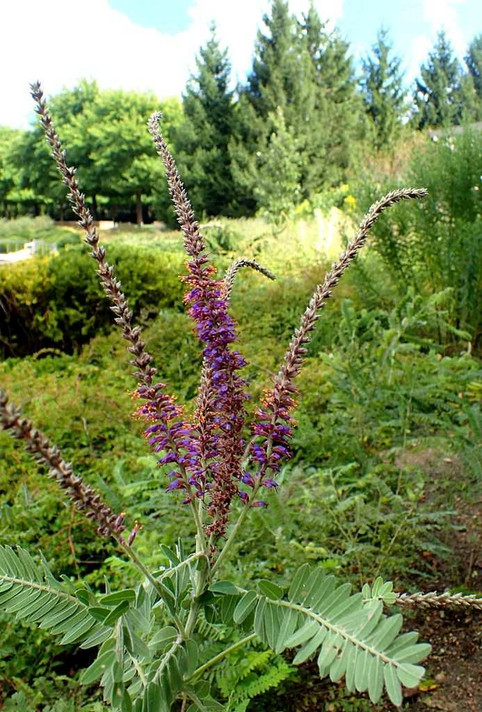Amorpha canescens - FALSE INDIGO (LEADPLANT)
False indigo, also known as leadplant, belongs to the pea/bean family and is one of the few true prairie shrubs. This deciduous (woody) perennial's delicate green foliage is covered in short hairs, giving it a silvery or dusty appearance. 4-8" spiked clusters of small, purple/blue-purple, pea-like flowers with gold anthers appear in midsummer.
Although it may take a few years to fully mature, it is quite long-lived (10 years) once established, and the deep taproot means this plant is incredibly drought tolerant and able to survive the wildfires that naturally sweep through open prairies. It does have some susceptibility to leaf spots, rust, powdery mildew and canker; good air circulation around the base of the plant will reduce the risk of these issues.
Perfect for naturalizing in a native, wildflower, or woodland garden, or planting in a prairie or meadow. Can be used as effective erosion control. Tolerates low levels of urban pollution; extremely intolerant of standing water.
Blooming Time: June - July
Size: 2-3' tall x 2-2.5' wide
USDA Zones: 3 to 8
Culture: full sun, well-drained soil, loam, sand; does well in poor, sandy, rocky, and somewhat dry soils - extremely drought tolerant
Moisture Needs: dry to average
Origin: central North America: from Montana, Wyoming, Colorado, and New Mexico to Michigan, Indiana, Missouri, Arkansas and Louisiana; it can be found in the Canadian provinces of Manitoba and Ontario, and ranges as far south as Texas (USDA distribution map)
Deer/Rabbit Resistant: yes / yes
Attracts Butterflies or Pollinators: yes / yes, also moths and other beneficial insects
Attracts Hummingbirds: yes
Pot Size: 3.5" x 5" perennial pot
Picture copyright: Krzysztof Ziarnek, Commons Wikipedia

Amorpha canescens - FALSE INDIGO (LEADPLANT)
False indigo, also known as leadplant, belongs to the pea/bean family and is one of the few true prairie shrubs. This deciduous (woody) perennial's delicate green foliage is covered in short hairs, giving it a silvery or dusty appearance. 4-8" spiked clusters of small, purple/blue-purple, pea-like flowers with gold anthers appear in midsummer.
Although it may take a few years to fully mature, it is quite long-lived (10 years) once established, and the deep taproot means this plant is incredibly drought tolerant and able to survive the wildfires that naturally sweep through open prairies. It does have some susceptibility to leaf spots, rust, powdery mildew and canker; good air circulation around the base of the plant will reduce the risk of these issues.
Perfect for naturalizing in a native, wildflower, or woodland garden, or planting in a prairie or meadow. Can be used as effective erosion control. Tolerates low levels of urban pollution; extremely intolerant of standing water.
Blooming Time: June - July
Size: 2-3' tall x 2-2.5' wide
USDA Zones: 3 to 8
Culture: full sun, well-drained soil, loam, sand; does well in poor, sandy, rocky, and somewhat dry soils - extremely drought tolerant
Moisture Needs: dry to average
Origin: central North America: from Montana, Wyoming, Colorado, and New Mexico to Michigan, Indiana, Missouri, Arkansas and Louisiana; it can be found in the Canadian provinces of Manitoba and Ontario, and ranges as far south as Texas (USDA distribution map)
Deer/Rabbit Resistant: yes / yes
Attracts Butterflies or Pollinators: yes / yes, also moths and other beneficial insects
Attracts Hummingbirds: yes
Pot Size: 3.5" x 5" perennial pot
Picture copyright: Krzysztof Ziarnek, Commons Wikipedia


